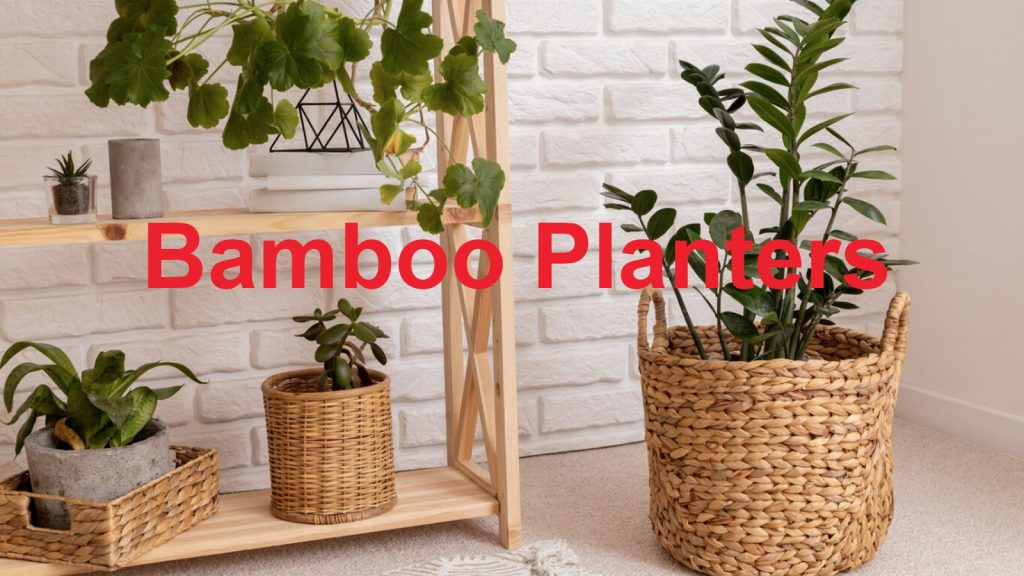Bamboo planters are a versatile and eco-friendly option for cultivating plants, adding a touch of natural beauty to any indoor or outdoor space. They are free from chemicals used for making plastic, last approximately five years unlike plastic planters that last longer and biodegradable within a year. Due to these facts, bamboo planters have become an alternative to plastic or iron planters.
Here are some key points to consider when it comes to bamboo planters:
- Sustainability:Bamboo is a highly sustainable material. It is one of the fastest-growing plants on Earth, making it an eco-friendly choice for planters. Unlike traditional wood, bamboo matures within a few years, minimizing environmental impact.
- Durability:Bamboo is known for its strength and durability. Bamboo planters can withstand various weather conditions, making them suitable for indoor and outdoor use. Properly treated bamboo planters resist pests and decay, ensuring a longer lifespan.
Bamboo is resilient, but extreme weather conditions can affect it. In extreme cold climates, bring bamboo planters indoors or provide protection against freezing temperatures.
- Aesthetic Appeal: Bamboo planters add a natural and exotic touch to any environment. The distinct appearance of bamboo brings a sense of tranquility and elegance to your space, making it a popular choice for those who appreciate a more organic and earthy aesthetic.
- Versatility: Whether you prefer a classic rectangular shape or a more unique and artistic form, bamboo can be adapted to suit your style. It also blends well with different types of plants, enhancing the overall visual appeal.
- Lightweight: Bamboo planters are generally lightweight, making them easy to move around and rearrange in your garden or living space. This feature is especially beneficial if you enjoy redecorating or need to move your plants to catch the sunlight or protect them from harsh weather conditions.
- Maintenance: Bamboo planters are relatively low-maintenance. Regular cleaning and a protective sealant can help maintain their appearance and extend their lifespan. Additionally, bamboo naturally resists moisture, reducing the risk of mold or mildew.
- Affordability:Bamboo planters are often more affordable than planters made from other materials, such as ceramic or metal, making them affordable for those looking to enhance their gardening or decorative endeavors without breaking the bank.
- DIY Possibilities:Bamboo’s flexibility and ease of manipulation make it an excellent material for DIY projects. If you enjoy crafting, you can create custom bamboo planters of various shapes and sizes to suit your needs.
Disadvantages of these Planters:
Decay in Certain Conditions:
While bamboo is durable, it can still decay over time, especially if not well- treated or exposed to prolonged damp conditions. Maintain regularly by sealing and protecting against pests.
Bamboo planters generally do well with standard potting soil. However, ensuring proper drainage is crucial to prevent waterlogged soil, which can lead to decay. Placing a layer of pebble at the bottom can help enhance drainage.
Limited Size Options:
Bamboo’s physical characteristics can limit the size and shape options for planters. Extremely large or intricate designs may require additional support or framing. Be mind-full of the size and weight of the plant when choosing a bamboo planter.
Color Fading:
The natural color of bamboo can fade over time, especially when exposed to sunlight. Some people appreciate the weathered look, but others may prefer to maintain the original color.
Vulnerability to Pests:
While bamboo is naturally resistant to many pests, it is not entirely immune. Some insects and fungi can still affect bamboo if not treated or well maintained.
May Crack or Split:
Bamboo may crack or split, especially if it dries up rapidly or subjected to drastic temperature changes. Proper care, such as regular moisturizing or sealing, can help mitigate this risk. While bamboo is strong and durable, extremely large or heavy plants may require additional support. Take into consideration the size and weight of the plant when selecting a bamboo planter.
Limited Insulation:
Bamboo may not provide as much insulation for plant roots as thicker, more solid planters from other materials. This can be a consideration for plants sensitive to temperature changes.
Smaller, simpler bamboo planters suitable for small plants or flowers can be affordable, ranging from $10 to $30.
The price for medium-sized planters with more complex patterns or ornamental features is between $30 and $60.
Large bamboo planters or custom-designed options can cost more. Prices for these can range from $60 to $150 or more, depending on the size and complexity of the design.
Planters from well-known brands or those with specific features such as advanced weather resistance or unique designs may cost more. Prices in this category can range from $50 to $200 or more.
Actual prices may vary based on location, availability, and the specific retailer. Additionally, handmade or artisanal bamboo planters with intricate designs or details may have higher price- points. If you’re looking for budget-friendly options, it’s worth exploring local gardening stores, craft markets or artisan fairs, farmers’ markets, Niche Eco-Friendly Retailers, Furniture and Home Decor Stores, online marketplaces, or home improvement stores. Keep in mind that while bamboo planters are often more affordable than some other materials, the overall cost may also be influenced by the craftsmanship and quality of the planter.
Conclusion:
Bamboo planters offer numerous advantages, including sustainability, durability, and aesthetic appeal, but they also come with challenges like potential decay, limited size options, and vulnerability to pests. Bamboo is a flexible material that can be easily shaped and molded in to different planter sizes and designs. DIY enthusiasts can also create custom bamboo planters. Choosing bamboo planters involves considering these factors and ensuring proper care and maintenance to maximize their benefits.
Read more about Limelight Hydrangea, How To plant, Grow And Care For Them here.

